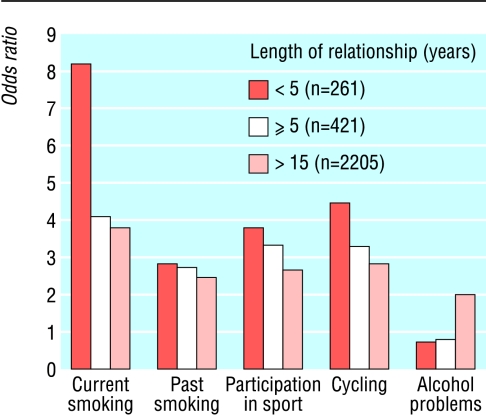Editor—Hippisley-Cox et al observed significant similarities for disease between spouses in a large sample of 8386 couples recruited through general practice.1 They think that shared environmental factors may cause these similarities but reject assortative mating as an explanation.
In a sample from the Netherlands twin register we could not replicate their spouse similarities for asthma, depression, diabetes, and cardiovascular disease, possibly because of our smaller sample size of 2152 spouse pairs.2 When we examined health behaviour in a larger sample we found good associations between spouses for smoking, alcohol problems, and exercise behaviour, even after controlling for age and body mass index of both spouses.
The duration of the relationship influenced these associations between spouses (figure). Except for alcohol problems, spouse similarities in health behaviour decreased as the duration of the relationship increased. This implies that assortment for these factors is based on similarity at the time dating began3 and highlights the importance of determining similarities in disease status at the time of dating, as suggested by Hippisley-Cox et al.
Assortative mating may further be based on social factors and personality traits. In our sample we found significant correlations between spouses for educational attainment, an indicator of socioeconomic status, which is also related to disease development. These correlations increased as the duration of the relationship increased (r=0.292, r=0.356, r=0.587 for <5 years, ⩾5 years, and >15 years, respectively), possibly owing to convergence of phenotypes of the spouses or to a higher divorce rate in dissimilar pairs.3 Significant correlations between spouses were also found for inhibition, a personality trait associated with increased risk behaviour, but these correlations were unaffected by the duration of the relationship (r=0.386, r=0.334, r=0.373 for <5 years, ⩾5 years, and > 15 years, respectively).
These results show that different mechanisms underlie similarities between spouses for health behaviour, social factors, and personality traits. The fact that similarities between spouses were found for this wide range of variables indicates, however, that assortative mating should not be hastily dismissed as a cause for spouse similarities in disease.
Any association between spouses does not exclude genetic effects. Hippisley-Cox et al assume that because spouses are unrelated, genes do not influence the association. But the similarity of spouses may be an example of an active genotype-environment correlation which occurs when a particular genotype is associated with the selection or creation of a particular environmental circumstance.4
Figure.
Odds of smoking (current smoking and ever smoked), participating in exercise (sport and cycling), and alcohol problems in women whose partner had the same lifestyle compared with women whose partner did not. Logistic regression analyses were adjusted for age and body mass index of both men and women
References
- 1.Hippisley-Cox J, Coupland C, Pringle M, Crown N, Hammersley V. Married couples' risk of same disease: Cross sectional study. BMJ. 2002;325:1–5. doi: 10.1136/bmj.325.7365.636. . (21 September.) [DOI] [PMC free article] [PubMed] [Google Scholar]
- 2. Boomsma DI, Vink JM, van Beijsterveldt CEM, de Geus EJC, Beem AL, Mulder EJCM, et al. Netherlands twin register: a focus on longitudinal research. Twin Res (in press). [DOI] [PubMed]
- 3.Price RA, Vandenberg SG. Spouse similarity in American and Swedish couples. Behav Genet. 1980;10:59–71. doi: 10.1007/BF01067319. [DOI] [PubMed] [Google Scholar]
- 4.Rowe DC. Assessing genotype-environment interactions and correlations in the postgenomic era. In: Plomin R, Defries JC, Craig IW, McGuffin P, editors. Behavioral genetics in the postgenomic era. Washington, DC: American Psychological Association; 2002. pp. 71–86. [Google Scholar]



